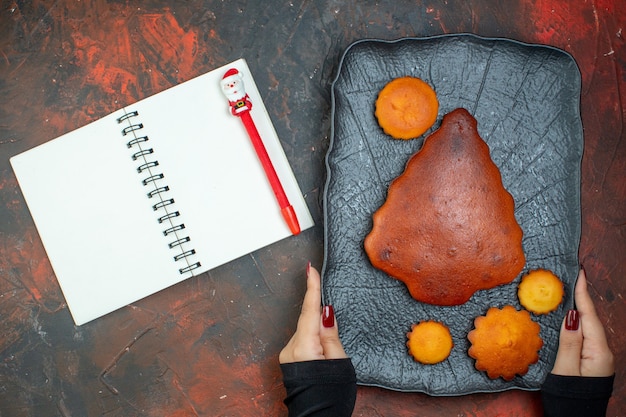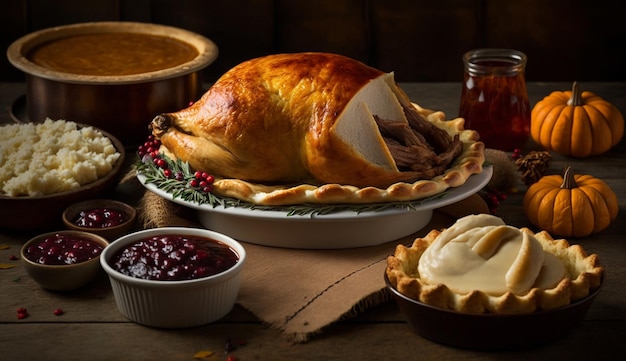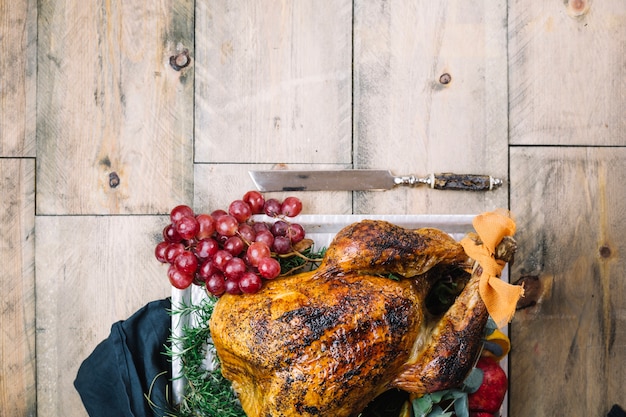The holidays are upon us, and with them comes the annual culinary challenge: conquering the mighty roast turkey. It's a tradition, a rite of passage, and let's be honest, a bit of a pressure cooker, especially when you're staring down a whopping 19-pound bird. That's a lot of turkey, folks! And I, for one, am both excited and a little terrified.
This year, I'm determined to nail it. I've learned from past experiences – burnt skin, undercooked breast, the infamous "turkey leg explosion" (yes, that really happened!), and I'm armed with a renewed sense of confidence, a decent-sized roasting pan, and a whole lot of tips and tricks I've picked up along the way.
Join me on this culinary journey as I tackle this culinary behemoth. Together, we'll navigate the world of turkey prep, cooking, and carving, and hopefully, emerge victorious with a succulent, golden-brown bird that'll have everyone at the table singing my praises.
You might be thinking: "19 pounds?! That's a giant bird! How on earth do you cook it?" Fear not, dear reader, because I'm going to share with you everything I've learned about conquering the mighty turkey. It's not as daunting as it seems, I promise. Let's dive in, shall we?
Part 1: The Turkey's Arrival - A Moment of Truth

The Big Reveal - Excitement and a Touch of Fear
The moment arrived. The delivery man, with a smile that could rival the sun, deposited a giant cardboard box on my doorstep. It was like a Christmas present, only instead of wrapping paper, it was covered in brown tape. I ripped it open, and there it was – my 19-pound turkey, nestled in a bed of styrofoam. It was impressive, a culinary leviathan, and I felt a surge of excitement and, let's be honest, a touch of fear. This was the real deal, and I was determined to do it justice.
The Inspection - A Closer Look
Next, the inspection. I carefully removed the turkey from its packaging, admired its plumpness, and gave it a good once-over. No weird smells, no suspicious discoloration - all good. I checked the cavity for any giblets, which were thankfully included, and gave the bird a quick rinse under the cold tap.
The Brine (or Not?) - A Culinary Debate
Now, here's where the debate begins. Do you brine your turkey or not? I've gone back and forth on this one. I've tried it both ways, and I'm still undecided. Some people swear by brining, claiming it makes the meat incredibly juicy and flavorful. Others argue it's unnecessary and can even make the skin soggy.
The truth is, there's no right or wrong answer here. It's a matter of personal preference and cooking style. For me, I've found that a well-seasoned turkey, cooked properly, can be just as juicy and flavorful without brining. It all boils down to your own culinary philosophy.
This year, I'm going with a dry brine. I'll rub the bird with a mixture of salt, pepper, and herbs, then leave it uncovered in the fridge for a day or two. It's a much easier process than soaking the bird in a giant bucket of brine, and I've found it delivers similar results in terms of tenderness and moisture. Plus, the dry brine helps to create a beautiful, crispy skin, which is always a bonus.
Part 2: The Prep Work - Getting Ready for the Big Bake

Stuffing or No Stuffing? - A Question of food safety
Another big question: Stuffing or no stuffing? This is a personal preference, but I'm firmly in the "no stuffing inside the bird" camp. I've learned the hard way that stuffing cooked inside the turkey doesn't always reach a safe temperature, which can be a recipe for disaster.
My solution? I make stuffing separately in a casserole dish, and it gets baked alongside the turkey. This way, I can ensure it's cooked through, and the turkey doesn't end up stuffed with a potential food safety hazard. Plus, it allows me to use different types of stuffing, whether it's a classic bread-based stuffing or a more adventurous wild rice stuffing.
The Secret Weapon: Butter - A Culinary Essential
It's a known fact: Butter makes everything taste better. And that's certainly true for turkey. I'm a big fan of slathering the bird with a good amount of butter before roasting. It adds richness, flavour, and helps create that beautiful golden-brown skin. I'm talking about a generous layer, folks. Don't be shy!
The butter also helps to keep the turkey moist during cooking, ensuring that it doesn't dry out. Plus, the butter will melt and baste the turkey during the roasting process, adding to the overall flavor.
The Herb Rub - A Flavor Infusion
Now, for the flavour infusion. I'm a big fan of using fresh herbs, but dried ones work just fine too. My go-to mix for a turkey rub includes: rosemary, thyme, sage, and a little bit of garlic powder. It's a classic combination that complements the turkey perfectly.
A bit of paprika adds a lovely colour and a subtle smoky flavour, so I usually throw some of that in as well. I'm not afraid to get creative, though. This year, I might try adding some orange zest for a touch of citrusy brightness, or maybe a pinch of cayenne pepper for a little heat. The possibilities are endless!
Part 3: The Big Bake - The Moment of Truth

roasting time - A Calculated Approach
The moment of truth has arrived. The oven is preheated to 350°F (175°C), and the turkey is ready to go. I've placed the bird in my roasting pan, breast-side up, and carefully placed it in the oven.
The recommended cooking time for a 19-pound turkey is around 3-4 hours. But here's the catch: every oven is different, and every turkey is unique. So, the best way to determine doneness is with a meat thermometer. I aim for an internal temperature of 165°F (74°C) in the thickest part of the thigh.
I also use the "pop-up timer" that comes with some turkeys, but I don't rely on it solely. It's a good indicator, but it's not foolproof. The meat thermometer is the ultimate judge of doneness.
The Basting Ritual - A Culinary Dance
Throughout the roasting process, I'll baste the turkey with its own juices, or with a mixture of butter and broth. This keeps the skin moist and helps the bird cook evenly. It's a bit of a ritual, and it adds a sense of satisfaction to the whole process. I usually baste every 30-45 minutes, and I like to use a basting brush to make sure the juices get evenly distributed.
Some people prefer to use a "turkey tent" to help the turkey cook evenly and prevent the skin from drying out too much. It's a piece of aluminum foil that is placed over the bird to create a "tent" effect. I've tried this in the past, and I've found it to be helpful, especially for larger turkeys.
The Rest - A Crucial Step
Once the turkey is cooked through, I take it out of the oven and let it rest for at least 30 minutes before carving. This allows the juices to redistribute throughout the meat, resulting in a juicier, more flavorful turkey. It's a crucial step that shouldn't be skipped. While the turkey is resting, I prepare the rest of the meal, so that everything is ready when the bird is ready to be carved.
Part 4: The Gravy Dilemma - A Culinary Challenge
Homemade or Not? - A Choice Between Tradition and Convenience
Ah, gravy. The pièce de résistance, the sauce that elevates the turkey to new heights of deliciousness. But here's the thing: making gravy can be a bit of a challenge, especially when you're dealing with a large turkey.
I've tried making my own gravy in the past, with varying degrees of success. Sometimes, it turns out beautifully, rich and flavorful. Other times, it ends up thin and watery, or even a little lumpy. It's a fickle mistress, this gravy.
The Pan Drippings - Gravy Gold
The key to good gravy is the pan drippings. After the turkey is removed from the oven, you'll find a delicious layer of fat and juices at the bottom of the roasting pan. This is gravy gold! The pan drippings are what give gravy its rich flavor and depth.
The Shortcut - A Practical Approach
This year, I'm taking the easy route. I'm going to use a gravy mix, but I'll still add the pan drippings for extra flavour. It's a bit of a cheat, but it's a reliable way to ensure I have a decent gravy without a lot of fuss. I'll whisk the gravy mix with some broth and then add the pan drippings, stirring until the gravy is smooth and thickened.
For those who want to try their hand at making gravy from scratch, I highly recommend using a roux. A roux is a mixture of butter and flour that is cooked until it forms a paste. This paste is then added to the pan drippings and broth to thicken the gravy. It's a bit more involved, but the results are well worth the effort.
Part 5: side dishes - A Feast for the Senses
A Feast for the Senses - A Culinary Symphony
No turkey dinner is complete without a smorgasbord of delicious side dishes. I love to create a variety of textures and flavours, from creamy mashed potatoes to crispy roasted vegetables.
This year, I'm planning to make:
- roasted brussels sprouts with bacon and balsamic vinegar - A classic combination with a touch of sweetness and savory.
- Creamy mashed sweet potatoes with a sprinkle of cinnamon - A comforting and indulgent side dish.
- Cranberry sauce, homemade, of course - A tangy and sweet counterpoint to the savory turkey.
- green bean casserole, a classic Thanksgiving favourite - A nostalgic dish that's always a crowd-pleaser.
- And, for a touch of whimsy, a sweet potato casserole with a pecan crumble topping - A delicious and decadent dessert.
It's a lot of food, but that's the beauty of a holiday feast. It's about sharing, gathering, and indulging in all the good things in life. The side dishes are just as important as the turkey, and they play a key role in creating a memorable dining experience.
Part 6: The Table Setting - A Festive Atmosphere
A Festive Atmosphere - Setting the Stage
No turkey dinner is complete without a beautifully set table. It's a small detail that can make a big difference in the overall dining experience.
I'll start by laying down a festive tablecloth, perhaps with a wintery pattern or a classic holiday design. Then, I'll add some placemats for a touch of elegance. I like to use placemats that complement the tablecloth but have a different texture. For example, if the tablecloth is made of linen, I might use placemats made of woven straw or cork.
The Fine China - A Touch of Elegance
Time to break out the good china! My grandmother's vintage china set always adds a touch of nostalgia to the occasion. I'll use the matching serving dishes and platters for a cohesive look. It's also a good idea to make sure you have enough serving spoons and forks for all of your guests.
Candles and Centerpiece - Creating Ambiance
A few candles, strategically placed around the table, add a warm glow and create a cosy atmosphere. I'll use a simple centerpiece of fresh greenery and cranberries for a touch of holiday cheer. I also like to use candles that have a festive scent, like cinnamon or pine.
The Finishing Touches - The Little Details That Matter
A few decorative napkins, a small bouquet of flowers, and some festive music playing in the background complete the picture. It's about creating an ambiance that invites relaxation, laughter, and conversation.
The key to a successful table setting is to create a look that is both festive and welcoming. It's about making your guests feel comfortable and appreciated.
Part 7: The Big Reveal (Again!) - The Moment of TruthThe Moment of Truth - Anticipation and Excitement
After hours of anticipation, the turkey is finally ready to be carved. I carefully transfer it to a serving platter, and let the glorious aroma fill the room. The scent of roasted turkey, herbs, and butter is intoxicating, and it fills everyone with a sense of anticipation and excitement.
The Carving Ceremony - A Culinary Performance
This is always a bit of a performance. I'll carefully carve the turkey, slicing it into thin pieces and revealing its succulent, golden-brown interior. The juices run freely, and the scent of rosemary and thyme fills the air. It's a moment of pure culinary satisfaction.
When carving a turkey, it's important to use a sharp carving knife. A dull knife will make the process more difficult and can even damage the meat. I also like to use a carving fork to help keep the turkey steady while I'm carving it.
The Presentation - A Feast for the Eyes
I'll arrange the turkey slices artfully on a platter, and surround it with an assortment of side dishes. The table is set, the food is ready, and the guests are gathered. It's a moment of pure joy and satisfaction.
The presentation of the food is just as important as the taste. A beautifully arranged platter of turkey and side dishes will make the meal even more enjoyable. I like to use a variety of colors and textures in my presentation, to create a visually appealing and tempting spread.
Part 8: The Aftermath - Enjoying the Fruits of Our Labor
The Leftovers - A Culinary Treasure
Let's be honest, we'll have plenty of leftovers. And that's a good thing! There's nothing quite like a turkey sandwich on the day after Thanksgiving.
I'll also use the leftover turkey to make turkey soup, turkey pot pie, and even turkey salad. There's no shortage of ways to repurpose the leftovers and enjoy the deliciousness of turkey for days to come.
The Turkey's Legacy - A Culinary Tradition
cooking a turkey is a tradition that spans generations. It's a way to connect with our past and to create new memories with our loved ones.
Part 9: Lessons Learned - A Culinary Journey
The Turkey's Secret - Simplicity and Patience
This year, I've learned a few valuable lessons about cooking a 19-pound turkey. First and foremost, it's not as daunting as it seems. With a little bit of planning, patience, and a good recipe, anyone can cook a delicious turkey.
The Importance of Patience - A Culinary Virtue
Cooking a turkey takes time. It's not a quick meal. But that's part of the beauty of it. It's a slow, deliberate process that allows you to savour the anticipation and enjoy the festive atmosphere.
The Power of Sharing - A Culinary Celebration
Finally, cooking a turkey is about more than just the food. It's about bringing people together, creating memories, and sharing a delicious meal with loved ones. It's a reminder that the simplest things in life are often the most meaningful.
FAQs
1. How long does it take to cook a 19-pound turkey?
The recommended cooking time for a 19-pound turkey is around 3-4 hours, but it can vary depending on your oven and the specific bird. The best way to determine doneness is to use a meat thermometer. Aim for an internal temperature of 165°F (74°C) in the thickest part of the thigh.
2. Do I need to brine my turkey?
Brining is a matter of personal preference. Some people swear by it, while others find it unnecessary. If you do brine your turkey, make sure to do it in advance, as it can take several hours or even overnight. A dry brine, where you rub the turkey with salt and spices, can be a good alternative to a wet brine.
3. What's the best way to make gravy?
The key to good gravy is the pan drippings. After the turkey is removed from the oven, there will be delicious fat and juices at the bottom of the pan. You can use these drippings to make a flavorful gravy, either from scratch or using a gravy mix.
4. What are some good side dishes for turkey?
The possibilities are endless! Some classic side dishes include: mashed potatoes, stuffing, cranberry sauce, green bean casserole, roasted vegetables, sweet potato casserole, and dinner rolls. Get creative and choose dishes that complement the turkey and your personal taste.
5. How do I store leftover turkey?
Leftover turkey should be stored in the refrigerator in an airtight container for up to 4 days. You can also freeze leftover turkey for up to 2 months. When reheating, make sure the turkey is heated to an internal temperature of 165°F (74°C) to ensure food safety.
Everyone is watching

How to Cook Frozen Lobster Tails Perfectly: A Step-by-Step Guide
RecipesLobster. Just the word conjures up images of lavish meals, special occasions, and a taste of luxury. But let's...

Pigs in a Blanket Cooking Time: How Long to Bake for Perfect Results
RecipesAh, pigs in a blanket. Just the name conjures up images of those delightful little parcels of crispy pastry en...

Pork Fillet Cooking Time: How Long to Cook It Perfectly
RecipesPork fillet, or tenderloin as it's sometimes called, is a real favourite in our house. It's so versatile, and...

The Ultimate Guide to Tender, Juicy Pulled Pork
RecipesRight, let's talk pulled pork. It's one of those dishes that just screams "comfort food," doesn't it? I mean...

The Ultimate Guide to Cooking Delicious Frankfurters
RecipesLet's face it, we all love a good frankfurter. It's a classic, simple, and always satisfying. But let's be rea...
